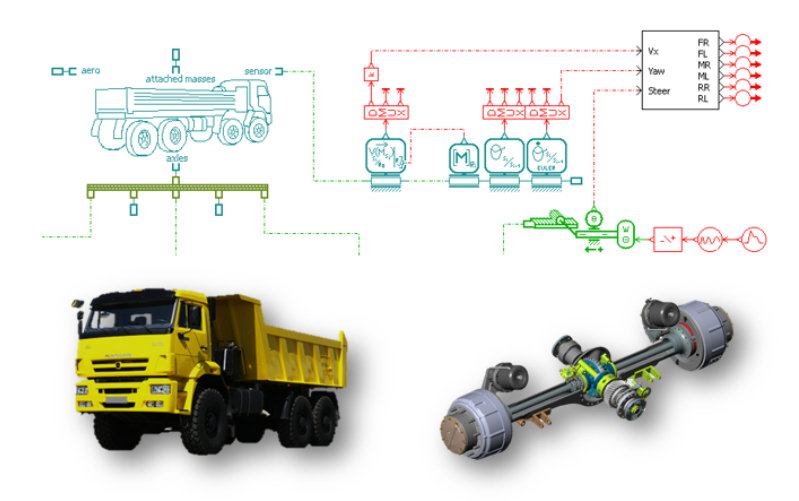As is well known, last year engineering centers were founded at several universities by decision of the Russian Ministry of Science as a result of an open, public contest. All the winning projects from the contest were approved by the Strategic Development Program Until 2021. One of the winners of the project was the Center of Computer Engineering at South Ural State University. We spoke with its research head, SUSU vice rector of strategic development, professor Andrey Vladimirovich Keller.
– Andrey Vladimirovich, the first question is a traditional one: why was the Center of Computer Engineering founded and what is done there?
– The SUSU Center for Computer Engineering offers engineering services for automobile and transport building, including vehicular, railroad, and light rail transport, track vehicles, and lifting and transport systems. The center’s activities are aimed at advancing innovative research developments enabling imports phase-out. The center completes design and technological developments, offers modeling, calculations, virtual testing, technical support for the creation of engineering prototypes, testing, and setting up machine-building products for manufacture, and also offers remote access for collective use.
But the main idea of the center is tied to computer engineering. The engineers at the Center of Computer Engineering received universal instruments which allowed them to complete mathematical simulations as close to reality as possible. Furthermore, modern mathematical modeling, the core of computer engineering, allows for multi-criteria parametric and topological optimization, whose results are often “outside the bounds of the chief designer’s intuition”. This allows for global, competitive developments of the new generation to be created quickly using new materials and modern technologies.
Scheme for imitative simulation and 3D-model of a drive axle for power distribution control systems for freight vehicles
– How do you rate the conditions of the Russian engineering services market?
– I want to note that the modern computer engineering market is, first of all, a market of complex proposals. Today it consists of two complementary segments – the engineering services themselves and the instruments for their computational support, including software and the hardware base for computation.
If we consider the situation on the international level then, by evaluation of the society of experts, the global market of engineering services is about 700 billion dollars. Russia has less than one percent of this market. Why? The thing is that in our country, engineering services have not been made into a unit of statistical measurement. Let’s remember the 80s and 90s: in that decade, no serious research or design work was done across the country. But in the soviet system of manufacturing, design was historically integrated into the profile of the industry’s institutions in special design bureaus. So, engineering did not exist as a separate area of work.
Meanwhile across the world engineering services have long been formed and distinguished as a separate industry with an emerging market and a long-time client base. So, we can say with confidence that Russia still in the stage of becoming a full-fledged market of engineering services.
According to expert estimates, the volume of the international engineering market has increased from 542 billion dollars to 725 billion USD over the last 8 years, and further growth is expected up to 4% a year. According to prognoses, the volume of the Russian market will grow two times faster than the international market with a speed of around 8% per year, and will grow to 272 billion rubles before 2019.
I want to note the key trends in the development of Russia’s market development. Fast technological changes and a growth of project complexity lead to the necessity of reducing the life cycle for the introduction of new products, the development of digital technologies, and a pronounced multidisciplinary nature of research. A convergence of industries occurs – the technologies and materials tested in one industry are spread in others. Principally new technologies and materials appear simultaneously.
Globalization, without question, makes a contribution to the change of engineering trends. Today a wider circle of countries is evident – technological leaders, the increased access to ideas, technologies, and potential partners. The geographical diversification of the market is continuing and there is a shift in the focus in the search for skilled labor from developed markets to developing markets. Global geopolitical issues make the issue of recycling and resource recovery in engineering research more actual.
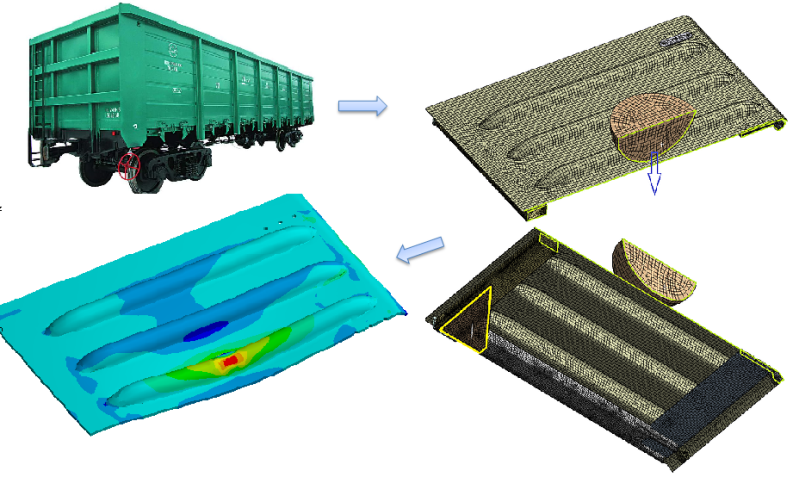
Simulation of bulk cargo falling on the load-bearing element of the undercarriage of an open railroad freight car
– And what about the concrete market volumes?
– According to the data of a statistical pilot investigation held by the Institute of Statistical Research and Economics of Knowledge at HSE, in which 102 large and medium-sized engineering organizations participated from 23 Russian federal subjects, the overall volume of engineering services offered by the organizations was 67.1 billion rubles, including 3.1 billion rubles for exports. The bulk of this – a bit more than 83% - went to engineering and technical design tied to the development of technical enquiries and proposals, technical and economic justifications, and design, working, and technological documentation.
The share of services for managing engineering projects, including the services of a general contractor and general planner, made up a small 10%. Other engineering services and consultations not relating to concrete projects for technical engineering design, for example, for technological or energy auditing, made up less than 7% of the market.

Stand for control testing of tramcar bogies
– How do you evaluate the competitiveness of the SUSU Center of Computer Engineering in that context?
– In the context of the Center of Computer Engineering’s competitiveness, I want to not that we win both as a result of high competency in the design of machine-building products and from unique equipment including supercomputer computational power.
It’s worth noting that the Center’s opportunities are based on SUSU’s scientific staff potential. SUSU, the largest university with many years of successful experience in completing projects ordered by companies of the real economic sector, and also based on close cooperation between the scientific and laboratory facilities, the university’s modern laboratories – the machine-building center, the experimental mechanics laboratory, and the laboratory of composite materials and constructions.
The creation of complex technical systems in the SUSU Center of Computer Engineering depends on quality work in the MBSE format (Model-Based Systems Engineering), which suggests significant changes to the approach to engineering analysis of technical systems. Our engineers went along the path of replacing physical experiments and prototypes with virtual prototypes – digital mockups. That’s how one of our key competitive advantages appeared – the cheapening and acceleration of developments using computer technologies.
On the other hand, the use of computer simulation enables the quick release of products on the markets, improves their quality and, in the end, allows us to radically increase performance and ensure the delivery of the essential competencies of industrial customers.
Looking at the situation as a whole, we must note that today there is competition on the Russian market for engineering solutions and, furthermore, as I already noted, there is a consistent tendency towards growth. The main participants in this competition are engineering departments at manufacturing companies and university engineering centers. International companies also make a contribution. Alongside that, the paradox of the situation is that the capabilities of Russian engineering centers do not completely cover the existing market demand.
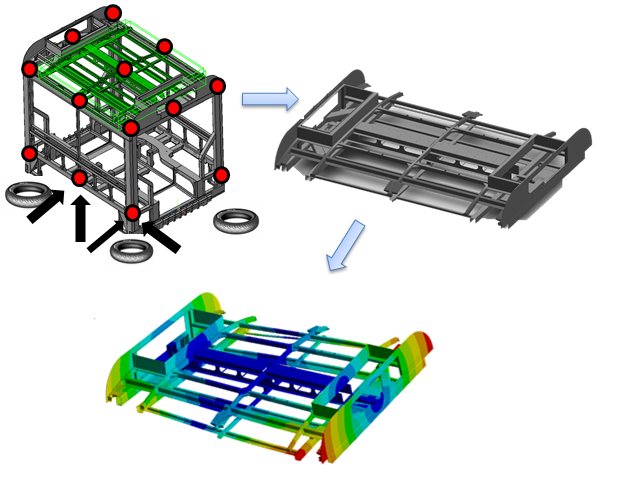
Vibration testing and simulation of an element of a tramcar frame
– Andrey Vladimirovich, what goals lie ahead for the engineering center?
– Our main goal is the sustainable development of the center as a base of quality engineering, the formation and progression of a packet of services in engineering and industrial design based on the integration of South Ural State University’s resources (its faculties, laboratories, and innovative departments) and resources from strategic partners – research and engineering organizations, engineering groups of the largest industrial machine-building companies in Russia, federal bodies of power, and state institutions and funds supporting the increased competitiveness and import phaseouts for products of Russian machine-building companies.
– Which mechanisms of state support has the center used for its foundation and development?
– In answering this question, I should first of all mention RF Government Regulation Number 218 from April 9th, 2010 On Measures of State Support for the Development of the Cooperation of Russian Academic Institutions of Higher Education and State Research Companies and Organizations Completing Complex Projects for the Development of High Technology Manufacturing within the Sub-program ‘Institutional Development of the Scientific Research Sector’ of the ‘Development of Science and Technology’ Governmental Program in the Russian Federation for 2013-2020.
The center’s engineers are working on a few large projects under the umbrella of this regulation. Among them are the creation of high-tech manufacturing of a new generation of energy-efficient transmissions for transport vehicles and busses and the high-tech manufacturing of highly accurate, multi-functional robotized systems for the development and manufacturing of bulky items.
In addition, the Center’s engineers are winners of the Federal Action Program “Research and developments in key areas of the development of Russia’s Scientific and Technological Complex for 2014-2020.” Scientific and technical solutions were developed within the state support from this program for power distribution control in transport vehicle transmissions to increase their energy efficiency and gas economy. Scientific and technical solutions for components of mobile charging devices for the batteries of hybrid and electric drive units for state transport and passenger transport vehicles were also developed.
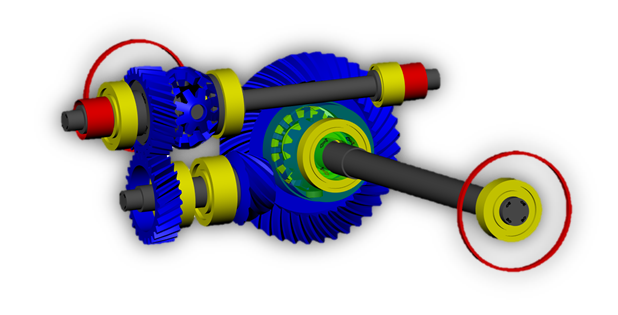
Simulation of transmission elements for freight vehicles
– I’ll ask an unpopular question: what issues does the center have?
– There really are many issues. I’ll list a few of them. First, the market trends today are such that investors are leaning more towards complex engineering services, preferring “key ready”, completed projects. There is an additional negative light from amplified competitive pressure from international engineering companies, most importantly, from China, who offer projects in said format. This is a serious challenge, and we are planning on beginning the completion “key ready” projects.
I want to also note as a challenge the necessity of building stable cooperative connections between engineering companies and science with the goal of unifying competencies and creating an integrative effect. This is a large and important strategic goal that can’t be achieved in one day, but is also necessary for engineering center to work effectively. We are working on this now.
– Please discuss how you look for your niche in the current crises, how to you attract clients and how do you work with them?
– It’s very interesting and multi-faceted work. I want to note immediately that the issue of engineering staff’s access to modern means of design and calculation is noted in small machine-building companies. There is also the obvious issue of a lack of engineering staff able to work with modern instruments. One great possible escape from this situation is the use of the Center of Computer Engineering’s capabilities. This is one of our real market niches.
One of the components of the strategy for advancing the Center’s services is participation in industry cluster structures which enables us to seize a large number of clients – both businesses and research and educational organizations. Positioning ourselves as a unified, collected engineering center for the region, the Center of Computer Engineering minimizes risks tied to the innovative activities of businesses, which allows us to increase the competitiveness of our products thanks to shorter timeframes and mistakes in design and less labor costs and expenses.
And of course I must mention our main strategic partners – the leaders of the Russian machine building market. Among them are manufacturing businesses, constant clients and partners for our center. This is the largest manufacturer of transport vehicles in Russia – KAMAZ PAO; businesses within the Uralvagonzavod corporation; one of the leaders of the Russian market for equipment for metallurgy, the mining industry, and the manufacture of building materials and energy – Uralmashzavod PAO; the leading developer and manufacture of moving parts for railroads and city transport systems, Transmashholding ZAO, and many more.
In addition, the Center of Computer Engineering works closely with the largest scientific and engineering organizations: state research centers FGUP NAMI (Central scientific research automobile and automotive engine institute "NAMI"), the leading research organization in the Russian Federation in the development of machine building; and VIAM (The All-Russian Scientific Research Institute of Aviation Materials); and also the Research Institute of Railway Transport.

3D model for the rear drive axle of a vehicle in assembly
– Can you name the projects aimed toward import phaseouts that the center is working on?
– On the whole, all of the Center’s projects are aimed at import phaseouts. I want to note that achieving the goals created by the government for the development of machine building in automobile transport, railway and light rail transport, agricultural transport, road building technologies, harvesting technologies, and lift and transport systems require the development of a new generation of competitive technical systems using new materials based on modern manufacturing techniques. This is what we are working on.
Of course, the most advanced technological chain able to provide true import phaseout, in my opinion, is the triad of “Materials & Computer Engineering & Manufacturing”. The absolute driver in this chain is computer engineering, which enables the breakthrough character of developments. We put our main focus on computer engineering in our projects.
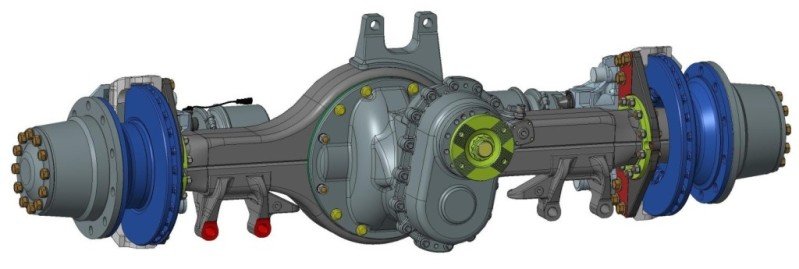
3D model for the middle (straight) drive axle of a freight vehicle in assembly
– Andrey Vladimirovich, does the Center of Computer Engineering plan on entering the international market?
– Of course. We recognize that the government has put a goal before engineering centers to achieve Russia’s technological excellence and leadership, taking world trends into account. So within international activities the Center of Computer Engineering is considering a few prospective areas of international cooperation.
First, I want to say a few words about our project for improving the passive safety of motor vehicles and means of protecting pedestrians. As a result of its completion, the Center will create supercomputer modeling for the load-bearing elements of the vehicles, dummies for virtual certification testing – front impact, side impact, rolling, etc. The Center’s engineers will optimize automobile body geometry and locations of deformation, reinforcing and energy-absorbing elements, etc. The project will be implemented with the Catholic University of Leuven from Belgium.
We are working on a project with that same university to optimize transmission characteristics and undercarriages to improve ride comfort, maneuverability, stability, and to lower the construction’s mass.
At the end of this project a series of multidisciplinary calculation models for automobiles will be founded using PO LMS, ANYS, and pSeven. This will allow for the realization of concepts of end-to-end digital design, beginning from the early stages and ending with a finished product.
One more area of our work is broadening the international base of material characteristics and properties for structural calculations. As a result, the international database of the famous British company GRANTA Design will be updated with characteristics of materials for heat-resistant steel and parameters of material models widely used in Russian atomic energy and aviation engine building.
Finally, there is an interesting project with the world leader for the production of machine tools – the German company Kliengelnberg. It is dedicated to the development of international tools for calculating elements of gear transmissions per the needs of domestic engineering. As a result of the realization of this project, these tools will be developed and adapted, taking into account national technological capabilities and materials identified in work between the Center of Computer Engineering and KAMAZ PAO, companies from the GAZ group, UMZ OOO, and more.
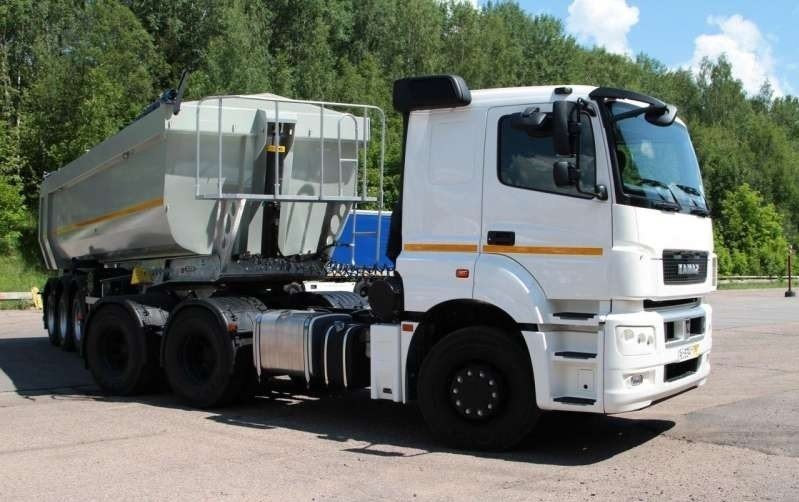
KAMAZ 65206 vehicle – overview
– It is no secret that one of the most important conditions for Russia’s technological advancement is advanced employee training. Does the Center offer this? Please tell us about this.
– I completely agree that science, technology, and academics must develop together, complementing and fueling one another. This requires time, and it’s the only way to achieve quality import phaseouts and technological advancements in domestic industry. We are involved in this work.
The Center of Computer Engineering and world leader, the Siemens company, are releasing a large educational project this September. A Siemens academic center will be founded at CCE which will train staff for lifecycle management of products and production. At this time, we are equipping the center with high-performance software. With its help, we will be able to train students, post-grads, and doctoral students, offer advanced training and professional retraining for engineers, and also complete research. This will allow us to build a complex academic process using examples of engineering solutions and offer training for qualified specialists in a broader range of engineering and interdisciplinary specialties according to the needs of modern industrial enterprises.
The academic center will be opened on September 14th, but active preparation is already underway. The university has given us a wonderful, comfortable location in the city center, furniture and electronics are being purchased, and at the opening we are planning on holding a large practical science conference, bringing the region’s engineering elite together.
– Let’s look to the future. What prospective projects is the center working on today?
– Of course, it’s always difficult to look to the future, but I can definitely say that the best is yet to come for our center. We started working not that long ago, and we have a huge number of tasks in front of us dedicated to active growth and increasing our market share.
We are planning expansion in a few components simultaneously to create a sustainable business. From the first day, we began working on developing ours staff potential and attracting talented engineers. We are literally collecting staff bit by bit – both experienced designers and young, talented graduates from engineering faculties. We recognize that engineering intelligence is the foundation for our future and we will continue working on searching for and attracting talented specialists.
We are also sure that the success of a high-tech business depends on the competencies of those in charge, and their ability to make strong and effective decisions. That’s why a lot of attention is paid to the management development of our team – we train top management in Skolkovo, receive management education in master’s programs. At the same time, we compare our ideas and study with our colleagues. We take part in all the important professional forums and exhibitions. In the coming months, we plan on introducing a CRM system and, with that, begin to build the management of our relationships with partners and clients on a whole new level.
In the future, is planning on expanding the engineering services we offer. We are interested in offering the widest spectrum of services possible in all stages of product lifecycle and in all sectors of machine building. We are already learning the potential of new markets, studying the needs of the engineering market for agricultural technologies, for example. We are planning on developing projects in robotized means of production. We separately identified the design of autonomous vehicles as a prospective area of development.
In a word, we have much work and many plans. We are looking to the future with optimism and we are sure that we can really develop the Center’s capabilities and, in the near future, increase our market share by more than two times.





